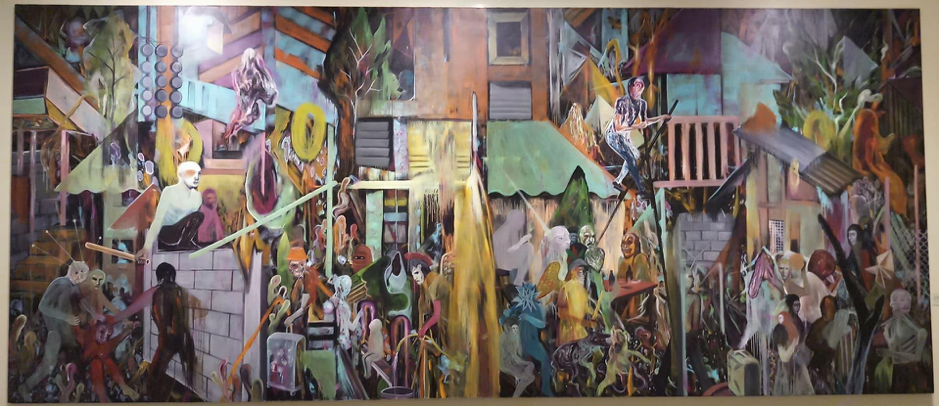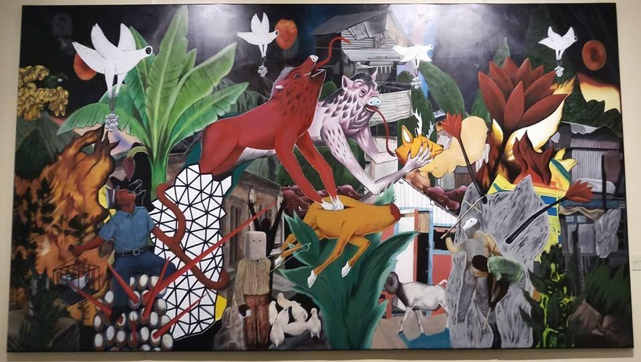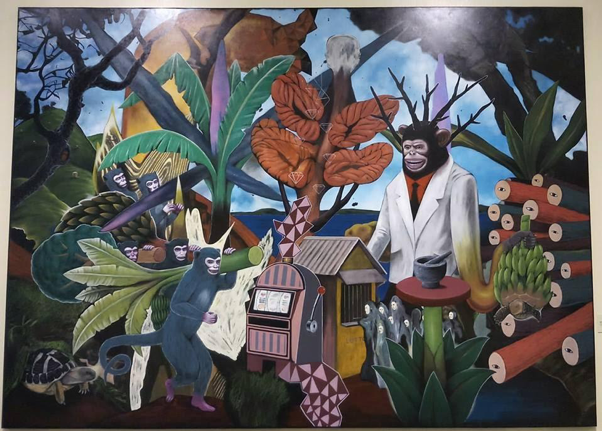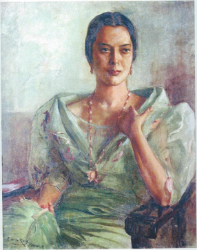Interestingly, the artist, Rodel Tapaya uses the word loobanto refer to the slums, a place we associate with marginalization. It’s the social, political, and economic experience of exclusion. The imagery of the word suggests segregation and partition, of being pushed to the edges of the border.Looban, meanwhile, implies insideness, even being at the center, instead of the periphery. But even in its interiority, loobanconnotes concealment, of something camouflaged, veiled, and hidden away. It’s a word which means being within and outside the walls. It is this theme that Tapaya explores in Urban Labyrinth, an exhibit of his recent works held at the Ayala Museum.
Entering the Looban

As we take our first step into The Market Chaos, we enter the looban. It’s not a grocery at a mall nor a department store. In fact, it closely resembles the tianggesof Divisoria and the palengke. The figures here are barely solid, their outlines dripping and blending into their surroundings. Everyone is in the midst of their individual and social transactions. The space and the ground they move in only hinted at, hurrying us to move along, and quickly.

Deeper into the looban, we explore the places the characters cohabitate. The painting, The Comedy, Parody and Tragedy, engulfs us in its immensity. We see multitudes of characters and micro-narratives in one huge canvas filled with recognizable scenes ranging from the familiar, to the grotesque and fantastical: a mother scolding a child, lovers locked in a kiss, a man getting beaten up, two dogs fighting, and a winged man holding a kris-sword.
Both paintings are a dizzying picture of an overcrowded space, with all the figures buzzing and active. Even the structures, bleeding into one another, refuse to be merely static facades. One can almost see them moving and as alive as the characters surrounding them, shifting like a labyrinth whose walls turn, disappear, and shoot out to confuse and trap both inhabitants and outsiders.
A Confrontation

The commotion in the looban reaches its peak in Aswangs Enter the City, a scene of carnage. Our eyes immediately go into the center of the action as two aswangs appearing as wild boars with elongated arms, human hands and beastly claws leap into the air. One bores into the flesh of a dead deer, and another holds its cleanly decapitated head. Both have their jaws open and their tongues stretched out, ready to devour the lamang-loob.
White winged creatures carry garlic stacks to ward off the monsters. A figure holds up a cross made of bamboo sticks, his head tilted upwards facing the aswangs in a brave but most likely doomed confrontation. Consider the figure under a banana tree with a ripe brown fruit, perhaps the source of the aswangs’ power. He’s in the midst of a transformation. Already, his skin is red, and his left arm a outstretched appendage encircling a geometric crystal-like shell where the aswangs leap out from. Most notably, he is wearing a police uniform and the irony is not lost to us, that the very institution in charge of protecting and safeguarding the people is also a monster that perpetuates the violence. It’s a picture of the abuse of power and of a helpless defense as the aswangs head into the direction of towering houses made of yero—their target: the looban.
Into the Kaloob-looban
It’s no secret that the looban is the most vulnerable to the problems of Philippine society, and that those who live there confront the worst of the abuses of power that culminate in the experience of poverty and violence. Hunger, crime, homelessness, and disease are daily struggles that demand immediate reliefs. Indeed, the looban’s confrontations occur in the everyday, the unbearable pressures weighing down in present-time.

It’s not surprising then that the painting, Instant Gratificationalludes to the cultural attitude of many Filipinos who long for immediate reliefs instead of long-term solutions. Inspired by Jose Rizal’s fable of a monkey and a tortoise, we see a monkey smugly carrying the upper-half of the banana tree thinking that since it’s the fruit-bearing half, he got the better end of the stick. Meanwhile, the tortoise plants the bottom-half, and waits patiently until it grows into a full banana tree, ripe with fruit. This fable is juxtaposed with another scene: a slot machine, and a line of people in queue for the lottery, all hoping for an easy fortune to finally gain freedom from the unbearable weight of present-time.
Leaving the Looban
The most feasible solution for those suffering the present entanglements of the looban, is to leave it. In a corner of the exhibition is a blackbox showing a short stop animation film, Kalahati Dalamhati, which depicts the plight of OFW’s by appropriating the legend of the manananggal—a creature which divides itself in half, leaving the bottom-part in a safe place, so the upper-body can take flight in search of human prey.
The divided nature of the manananggal visually demonstrates the emotional struggle of overseas workers who leave the country to provide for their families. In the film, the OFW-father’s upper-half flies away, not in bat wings but white angel wings, carrying a luggage. His lower-half remains with his wife and son who are always seen waiting upon it. In the end, the father returns and reattaches itself to the waist, becoming whole again. But the son follows his fathers’ footsteps and leaves the looban, causing us to wonder about the complexity of integration, and the difficulty of working for a life inside the looban.
Navigating the Chaos
The exhibition confronts us with the realities of these neglected urban environments. To navigate the looban is to see the truth that the abuses of power are inherent in the system, perpetually separating and excluding the looban. It continues to be a publicly camouflaged sight, ignored yet acknowledged, while the rest of privileged society are shielded, largely unaffected by the chaos, and safe from the present confrontations the looban is burdened with everyday.






